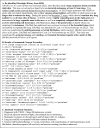Natural language processing and the oncologic history: is there a match?
- PMID: 22043196
- PMCID: PMC3140455
- DOI: 10.1200/JOP.2011.000240
Natural language processing and the oncologic history: is there a match?
Abstract
Purpose: The widespread adoption of electronic health records (EHRs) is creating rich databases documenting the cancer patient's care continuum. However, much of this data, especially narrative "oncologic histories," are "locked" within free text (unstructured) portions of notes. Nationwide incentives, ranging from certification (Quality Oncology Practice Initiative) to monetary reimbursement (the Health Information Technology for Economic and Clinical Health Act), increasingly require the translation of these histories into treatment summaries for patient use and into tools to assist in transitions of care. Unfortunately, formulation of treatment summaries from these data is difficult and time-consuming. The rapidly developing field of automated natural language processing may offer a solution to this communication problem.
Methods: We surveyed a cross section of providers at Beth Israel Deaconess Medical Center regarding the importance of treatment summaries and whether these were being formulated on a regular basis. We also developed a program for the Informatics for Integrating Biology and the Bedside challenge, which was designed to extract meaningful information from EHRs. The program was then applied to a sample of narrative oncologic histories.
Results: The majority of providers (86%) felt that treatment summaries were important, but only 11% actually implemented them. The most common obstacles identified were lack of time and lack of EHR tools. We demonstrated that relevant medical concepts can be automatically extracted from oncologic histories with reasonable accuracy and precision.
Conclusion: Natural language processing technology offers a promising method for structuring a free-text oncologic history into a compact treatment summary, creating a robust and accurate means of communication between providers and between provider and patient.
Figures

References
-
- American Society of Clinical Oncology. QOPI Summary of Measures, Fall. 2010. http://qopi.asco.org/Documents/QOPIFall2010MeasuresSummary.pdf.
-
- Office of the National Coordinator for Health Information Technology (ONC); Department of Health and Human Services. Health information technology: Initial set of standards, implementation specifications, and certification criteria for electronic health record technology—Final rule. Fed Regist. 2010;75:44589–44654. - PubMed
LinkOut - more resources
Full Text Sources

